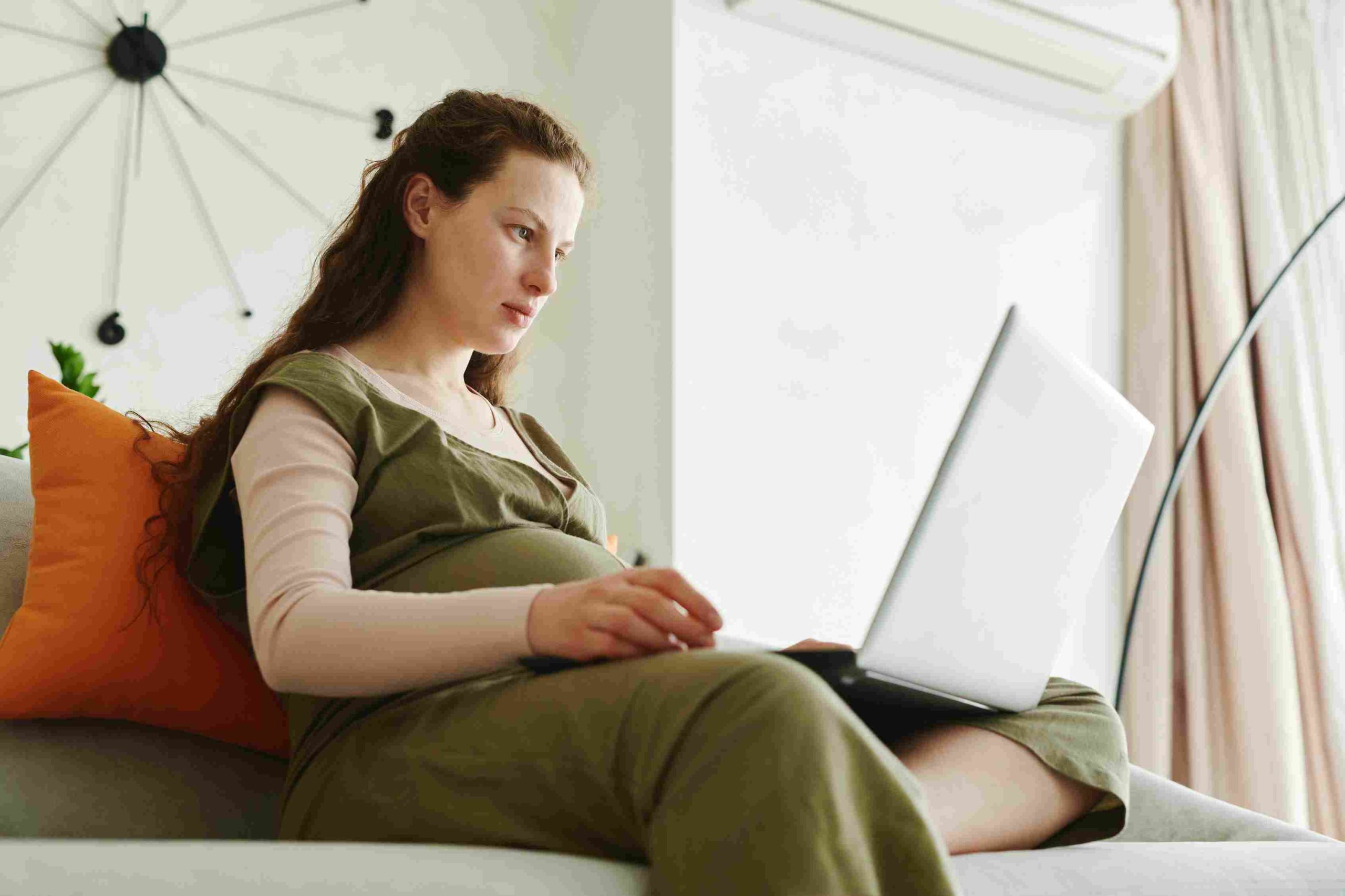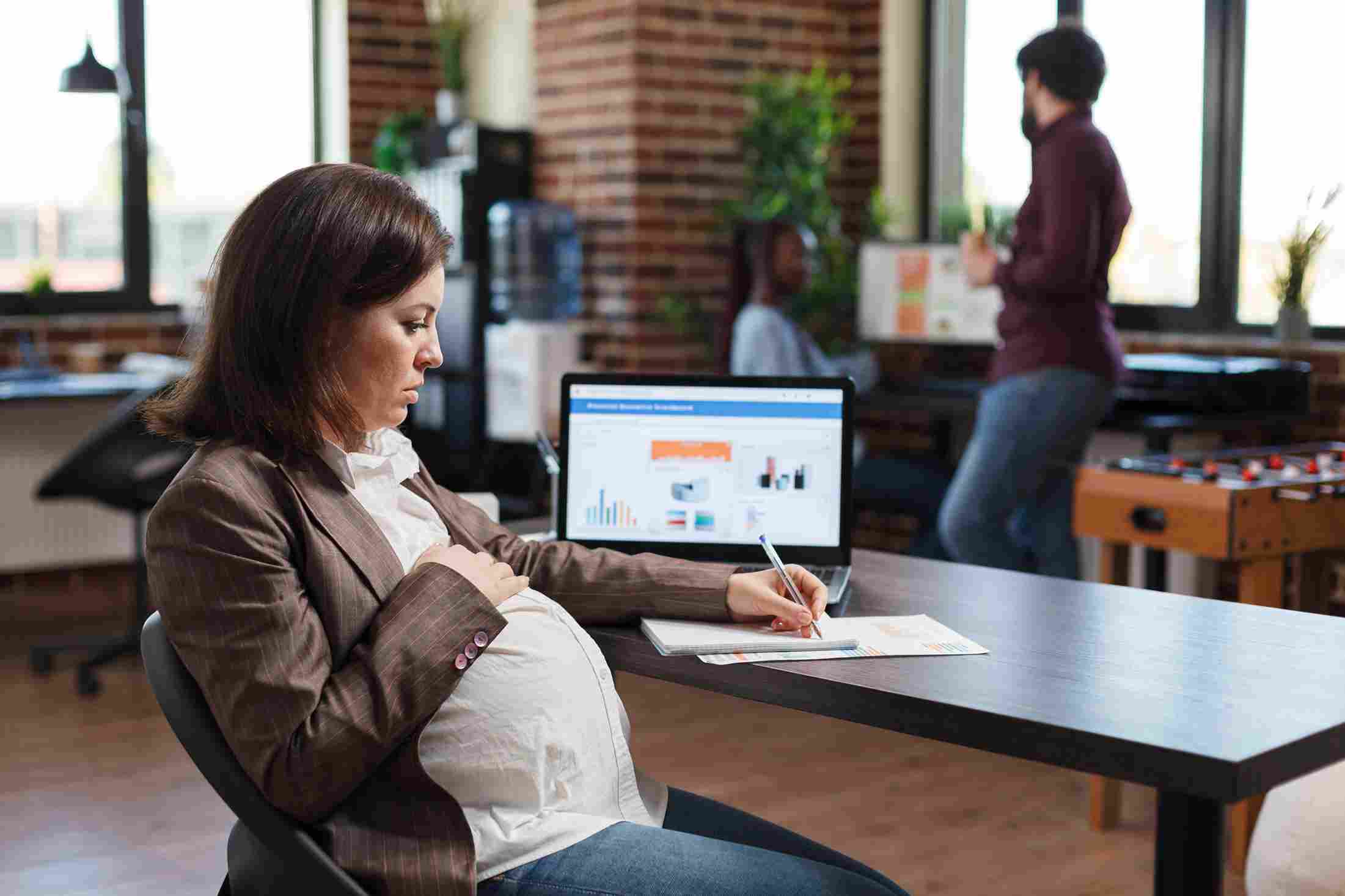Navigating employers’ responsibilities to maternity leave is complicated. Fortunately, we’re breaking down maternity leave in Ireland that covers maternity leave length, initiating the application process, the financial support you’re entitled to, and key rights to be aware of during and after your leave.

Understanding Your Maternity Leave Entitlements
In Ireland, maternity leave is a legal right protected under the Maternity Protection Acts. The law entitles employees to a basic maternity leave period of 26 weeks. This period can commence at any time, but it must begin two weeks before the end of the week the baby is due at the latest.

But what happens after the basic week’s maternity leave period ends?
Well, the law goes a step further and offers an additional 16 weeks of unpaid maternity leave. This extended period is optional and includes social insurance contributions for each week.
How Long is Maternity Leave in Ireland?
The duration and commencement of maternity leave are critical aspects to consider. Pregnant employees must take at least two weeks of their maternity leave before the week when the baby is due. However, if the baby decides to make an early appearance more than two weeks before the due date, the mother can start her maternity leave from the actual date of birth.
It is generally recommended to start maternity leave at least two weeks before the due date and continue for at least four weeks after birth.
Additional Unpaid Maternity Leave in Ireland
Availing of the additional unpaid maternity leave can provide employees with more bonding time with their new-born. This period of 16 weeks can commence immediately following the standard 26 weeks of maternity leave. To apply for this extension, the employee must provide at least 4 weeks’ written notice to their employer along with a medical certificate confirming pregnancy.
The catch, however, is that during this additional unpaid maternity leave, Maternity Benefit is not provided, and employers are not legally required to pay. But the silver lining is that employees are entitled to credited social insurance contributions for each week of leave taken.
What’s more, if an employee becomes ill during this period, they can request to terminate the leave, switch to sick leave and possibly receive an Illness Benefit.
Maternity Pay Ireland
The standard payment for maternity leave Ireland is €274 per week for 26 weeks or 156 days.
Applying for Maternity Benefit in Ireland
Most women in Ireland will be able to access a Maternity Benefit is a payment scheme for women on maternity leave covered by social insurance (PRSI). Bear in mind that you must have enough PRSI contributions and be on certified maternity leave to qualify.
The standard payment rate for Maternity Benefit as of 2024 is €274 per week.
You’ll need to apply for Maternity Benefit at least 6 weeks before your planned maternity leave to ensure that your application is processed and that you receive the support you need! On the other hand, for self-employed individuals, the application should be made at least 12 weeks in advance and must include a completed MB3 Medical Certificate after the 24th week of pregnancy.
The other option for employers is to keep paying employees in full and instead request that the Maternity Benefit be paid to the company directly.
Eligibility for Maternity Benefit
To be eligible for Maternity Benefit, the applicant must be pregnant, have recently given birth, or in the case of a stillbirth or miscarriage, have been recently pregnant. Apart from pregnancy, the eligibility for Maternity Benefit also hinges on the applicant being in employment, having recently ceased employment, or being self-employed, with a sufficient number of PRSI contributions.

In the event of a stillbirth or miscarriage, an employee must submit a medical confirmation which includes the expected date of birth, the baby’s actual date of birth, and the number of weeks into the pregnancy.
The Application Process
The application process for Maternity Benefit is straightforward and involves the following steps:
- Provide a certificate from your doctor confirming the baby’s due date.
- Have your maternity leave certified by your employer. Employers are required to complete the maternity benefit application form, form MB2.
- If you are self-employed, submit a completed form MB3, certified by your doctor.
Apart from the basic documents, applicants may need to provide additional personal information such as address, details of any children, and relationship status during the application process. Maternity Benefit applications must be made at least 6 weeks before the planned maternity leave begins, or 12 weeks in advance if self-employed.
How to Support Employees During Maternity Leave
Supporting an employee during maternity leave is an essential part of providing a working environment that is inclusive and values all employees, whatever their current status, and invests in the future productivity of current employees. Getting support right is also key to avoiding misunderstandings that may lead to legal disputes.
At a basic level, keep all maternity leave documentation accessible and ensure communication is clear and consistent.
Here are some practical tips for how to support employees before, during and returning from maternity leave:
Before Maternity Leave
Before maternity leave begins, it’s essential to agree on a clear plan for the start date, intended duration, and any required notice period for returning to work. Agreement around a handover plan and knowledge transfer is also essential to establish what needs to happen before the employee goes on leave. Assign a point of contact to handle questions while the employee is out of the office, and set expectations for communication, keeping in touch and check-ins.
During Maternity Leave
While an employee is on maternity leave, employers can provide support by celebrating milestones and sharing details of wellbeing support, such as employee counselling and return-to-work options. It’s also a good idea to check with the employee whether they want to receive newsletters or team updates to feel connected, and to reiterate to other team members the expectations for professional contact.
Preparing for Return
Offering a phased return to work can support an employee returning from maternity leave, as it allows them time to settle the baby into childcare and adapt to their new role as a working parent. Consider remote and flexible options as part of this. Dedicate time to ensuring the employee is up to date on changes that have occurred while they have been away, and providing training, refreshers, or mentoring can support reintegration. Pairing the employee with another staff member who has returned to work from maternity leave can work well, too.
Health and Safety Considerations During Pregnancy
Health and safety during pregnancy is a significant aspect that needs careful attention. Employers must conduct a risk assessment to identify any potential hazards to the health of pregnant employees and their developing child, taking necessary action to mitigate these risks.

If a medical certificate is provided indicating that nighttime work is harmful to a pregnant employee’s health, the employer is obligated to provide suitable daytime work.
Certain work hazards that should be avoided during pregnancy include:
- Pressurization chambers
- Unimmunized rubella exposure
- Toxoplasma
- Lead
- Demanding physical tasks
A risk assessment is required before a pregnant or breastfeeding employee works with these hazards.
Furthermore, workplaces must accommodate pregnant, postnatal, and breastfeeding employees with adequate conditions for rest, specifically the ability to lie down when needed, as per regulatory standards.
Health and Safety Leave in Ireland
Health and Safety Leave comes into play when risks at work cannot be mitigated by adjusting conditions or hours, and no suitable alternative work can be provided. This provision is applicable to employees exposed to risks at their workplace, night workers, or breastfeeding within the first 26 weeks after birth.
During the initial three weeks of Health and Safety Leave, employees receive their normal wages, followed by Health and Safety Benefit payments depending on their earnings and PRSI contributions. However, there are various conditions under which employees can be disqualified from receiving Health and Safety Benefit, such as receiving Maternity Benefit, cessation of workplace risks, or incarceration.
Risk Assessment and Suitable Work
Risk assessment and provision of suitable work are the employer’s responsibilities. Employers are mandated to carry out risk assessments for pregnant employees to ascertain hazards present, considering exposure frequency and duration, and take action to minimise such risks. The risk assessment for pregnant workers should cover various potential hazards such as:
- physical shocks
- vibrations
- handling of loads
- environmental extremes
- movements that are abrupt or severe
- exposure to radiation
- harmful agents including biological, chemical, stress, or instances of bullying
If the workplace poses a hazard to the pregnant employee that cannot be removed, the employer must adapt the employee’s work conditions or hours, or offer suitable alternative work.
Protections Under the Maternity Protection Act in Ireland
The Maternity Protection Acts 1994 and 2004 are pivotal pieces of legislation that establish the statutory minimum entitlements for maternity leave and maternity at work in Ireland. While on maternity leave, all employee rights and benefits are fully maintained.
This means that maternity leave is counted as service for the purposes of:
- promotion
- seniority
- entitlement to increments
- reckonable service for pension purposes under the Civil Service Superannuation Scheme
Additional rights under the Maternity Protection (Amendment) Act 2004 include the right to time off for breastfeeding.
Job Security During Leave
Job security during maternity leave is a crucial concern for many expectant mothers. The law ensures that employees are entitled to return to the exact same job with the same contract of employment after maternity leave. If the specific same job is unavailable, the employer is obligated to provide a suitable alternative position with terms that are no less favourable than the previous contract.
Protection Against Dismissal
The Maternity Protection Act significantly protects employees against dismissal during maternity leave. The law explicitly protects employees from being dismissed due to reasons connected with their pregnancy or maternity leave. Moreover, employers cannot terminate an employee’s contract while they are on maternity leave, as it is protected by maternity protection legislation.
In case of disputes with employers over maternity rights, complaints can be made to the Workplace Relations Commission. If there is a suspicion of unfair dismissal after returning to work from maternity leave, it is advisable to seek advice from experienced experts without delay.
Breastfeeding and Working Hours Adjustments in Ireland
Employers are required to make appropriate adjustments to working hours as this is considered another essential aspect of maternity leave. Employees who are breastfeeding are entitled to one hour off work with pay each day until the child reaches the age of 2.
Lactation breaks can be utilised as either one continuous hour, two 30-minute halves, or three 20-minute segments, and further variations may be accommodated if mutually agreed with the employer.
Moreover, the hour of lactation break entitlement may also be used to adjust working hours for breastfeeding purposes. Although employers are not required to provide dedicated breastfeeding facilities if it incurs considerable costs, they must accommodate lactation breaks or working hours adjustments.
Lactation Breaks in Ireland
Breastfeeding mothers are entitled to take breaks to breastfeed or express milk. You can choose to take a 60 minute break, two 30 minute breaks, or three 20 minute breaks from the options available. Each option offers flexibility in managing your break time..
Mothers in Ireland can take these paid lactation breaks until the child’s 2nd birthday, during an 8-hour working day. If a suitable place for breastfeeding or expressing milk is unavailable at the workplace, the employer may instead reduce the mother’s working hours without any loss of pay.
Adjusting Working Hours
Breastfeeding employees returning to work within 26 weeks after childbirth are entitled to an hour of paid leave per day for breastfeeding or expressing milk. If the employer cannot provide suitable facilities for breastfeeding, breastfeeding employees are entitled to a reduction in working hours without loss of pay.
The provision of suitable facilities for breastfeeding in the workplace is at the employer’s discretion.
Partner Paternity Rights in Ireland
Paternity leave and partner rights are essential aspects of maternity leave as well. The Paternity Leave and Benefit Act 2016 establishes the right to paternity leave in Ireland for:
- fathers
- same-sex couples
- partners of mothers
- parents of a donor-conceived child
Paternity leave in Ireland grants new parents 2 weeks off work, which can be utilised within the first 6 months following the child’s birth or adoption.
Although employers are not required to pay employees during paternity leave, eligible individuals may receive Paternity Benefit from the Department of Social Protection with sufficient PRSI contributions.
Employees must inform their employer at least 4 weeks in advance of taking paternity leave, providing in writing a doctor’s certificate stating the expected date of birth, actual birth date, or a placement certificate in case of adoption.
Paternity Leave in Ireland
Fathers are entitled to paternity leave in the following situations:
- Upon the birth or adoption of a child
- In the event of a stillbirth or miscarriage after the 24th week of pregnancy
- If the baby has a birth weight of at least 500 grams.
Attending Ante Natal Classes
Partners have the right to take paid time off to attend two antenatal classes shortly before the birth. This time off allows them to support their partners and prepare for the arrival of their baby. This entitlement to attend antenatal classes applies only to one set of classes per pregnancy, and is not available for subsequent pregnancies.
To exercise this right, partners must notify their employer in writing at least 2 weeks before the classes commence, specifying the dates and times of the classes.
Special Circumstances: Premature Births and Hospitalisation
Maternity leave entitlements also cater to special circumstances such as premature births and hospitalization. In the event of a premature birth, the maternity leave can be extended by contacting the Maternity Benefit section and providing written confirmation from a doctor specifying the baby’s actual birth date versus the original due date.
In the case of hospitalisation of the baby, maternity leave can be postponed. This process is initiated upon hospitalisation. The standard paid maternity leave can be postponed for a maximum period of 6 months in the event of the baby’s hospitalisation.
Extended Maternity Leave for Premature Births
Mothers must meet the ordinary qualifying criteria to qualify for an additional period of paid maternity leave due to premature birth. The extended maternity leave period due to premature birth is calculated from the baby’s actual birth date until the original planned start date of maternity leave.
To claim extended maternity leave for premature birth, a written notice must be provided to the employer within 14 days of the baby’s birth.
Postponing Maternity Leave
Employees may opt for postponed maternity leave if the baby is hospitalised, under the condition that:
- At least 14 weeks of maternity leave have been taken, including a mandatory 4-week period post-birth
- The mother must provide written notice to her employer, who must then agree to the postponement
- The remaining leave must be taken in one block within 7 days of the baby’s discharge from hospital
Annual Leave and Public Holidays
During maternity leave, including unpaid maternity leave, employees are considered to be employed, enabling them to continue accruing annual leave entitlements as though they were working. During their standard maternity leave or the additional maternity leave period, employees are entitled to leave for any public holidays that occur. This ensures that they can fully benefit from their time off..

Annual leave accrues during both the paid maternity leave and the unpaid additional maternity leave, with no interruption to the accrual seen as a break in service.
Returning to Work After Maternity Leave
Returning to work after maternity leave is a significant transition that requires careful planning. Employees must notify their employer in writing at least four weeks before the intended return date from maternity leave. Breastfeeding employees also need to inform their employer in writing at least 4 weeks before returning to work if they intend to take breastfeeding breaks.
Upon returning to work after maternity leave, employees are entitled to return to their same position or to a role of at least equal status, pay, and conditions.
Notice Requirements for Return
Employees must provide at least four weeks’ written notice of their intention to return to work after maternity leave. Failure to comply with the notice requirements may result in the loss of an employee’s rights upon returning to work.
However, late notification of the intention to return to work from maternity leave is accepted if it was not reasonably practicable for the employee to notify the employer earlier.
Employment Terms Upon Return
Upon returning from maternity leave, the employee is entitled to return to their same position with the same contract of employment, ensuring job continuity. If it is not feasible for an employee to return to the same position after maternity leave, employers are required to provide suitable alternative work on terms not less favorable than the original job.
Irish Maternity Leave Frequently Asked Questions
How long is maternity leave paid Ireland?
In Ireland, maternity leave is paid for 26 weeks, or 156 days, with at least 2 weeks and not more than 16 weeks taken before the end of the week in which the baby is due.
How long do you get on maternity leave?
You are entitled to 26 weeks of basic maternity leave if you have enough social insurance contributions. This includes self-employed individuals.
Can I extend my maternity leave if my baby is born prematurely?
Yes, you can extend your maternity leave if your baby is born prematurely. Contact the Maternity Benefit section and provide written confirmation from a doctor specifying the baby’s actual birth date versus the original due date.
What are my rights if my job is not available after my maternity leave?
If your job is not available after your maternity leave, your employer is obligated to provide a suitable alternative position with terms that are no less favorable than your previous contract.
How do I apply for maternity benefit?
To apply for Maternity Benefit, you need to obtain a certificate from your doctor confirming the due date of the baby and have your maternity leave certified by your employer. It’s important to submit your application at least 6 weeks before your planned maternity leave begins (or 12 weeks in advance if you are self-employed).
How much is the maternity benefit in Ireland?
The standard rate for maternity benefit in Ireland is €289 per week for 26 weeks. The payment is taxable, but you don’t pay PRSI (Pay Related Social Charge) and USC (Universal Social Charge) on it. If you receive other social welfare payments, you will get half the maternity benefit.
Employers can ‘top up’ maternity pay depending on their own maternity leave policy.
Can I extend my maternity leave if my baby is born prematurely?
Yes, if your baby is born prematurely, you can get additional paid maternity benefit beyond the standard 26 weeks. The Department of Social Protection will add extra weeks to your maternity benefit from the time of your baby’s birth to two weeks before the expected start of your maternity leave period.
You must have received at least 14 weeks of maternity benefit and taken at least four weeks of it after the baby’s birth to qualify.
If your baby is born before your maternity leave is due to start, notify the Maternity Benefit Section with your doctor’s confirmation of the birth.
Can I claim maternity benefits if I’m self-employed in Ireland?
Yes, if you are self-employed, you can claim maternity benefit provided you have met the PRSI contribution requirements. The Citizens Information website page on maternity benefit details the different options.
If you have not met the threshold for contributions but have previously had insurable employment, some earlier PRSI may help you qualify.
When applying for maternity leave as a self-employed person, ask your doctor to fill in the Medical Certificate for Maternity Benefit (MB3). Note that if you are self-employed you must apply for the benefit at least 12 weeks before your planned maternity leave.

